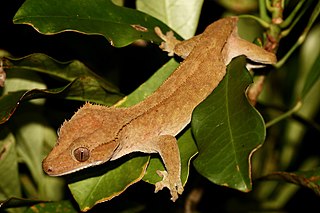
Bavayia is a genus of lizards in the family Diplodactylidae. Species in the genus Bavayia are also known commonly as New Caledonian geckos or bavayias. The genus is native to the remote New Caledonia and Loyalty Islands. The 41 species are moderately small to medium-sized geckos, and are distinguished from other genera by their tail length and the shape of their digits.

Eurydactylodes is a small genus of geckos commonly referred to as chameleon geckos from the subfamily Diplodactylidae, endemic to New Caledonia and few adjacent islands. Within the Diplodactylidae, Eurydactylodes resides in the Carphodactylini tribe, and consists of four species. All species share similar morphology as well as lifestyle and habits. The first of the Eurydactylodes species to be classified, E. vieillardi, was discovered in 1869.

Rhacodactylus is a genus of medium to large geckos of the family Diplodactylidae. All species in this genus are found on the islands that make up New Caledonia.

The crested gecko or eyelash gecko is a species of gecko native to southern New Caledonia. In 1866, the crested gecko was described by French zoologist Alphonse Guichenot. This species was thought to be extinct until it was rediscovered in 1994 during an expedition led by Robert Seipp. Along with several other New Caledonian gecko species, it is being considered for protected status by the Convention on the International Trade in Endangered Species of Wild Flora and Fauna.

Rhacodactylus leachianus, commonly known as the New Caledonian giant gecko,Leach's giant gecko,Leachianus Gecko, or simply Leachie, is a large species of gecko in the family Diplodactylidae. The species, which was first described by Georges Cuvier in 1829, is endemic to New Caledonia.

Mniarogekko chahoua is commonly known as the mossy New Caledonian gecko, short-snouted New Caledonian gecko, Bavay's giant gecko, or mossy prehensile-tailed gecko. It is an arboreal gecko found natively on the southern portion of the island of New Caledonia and on the outlying islands of Île des Pins.
The rough-snouted giant gecko, also known as the greater rough-snouted gecko or tough-snouted gecko, is a species of gecko found in New Caledonia.
Antoine Alphonse Guichenot was a French zoologist who taught, researched, and participated in specimen collecting trips on behalf of the Muséum national d'histoire naturelle (Paris), including an extensive biological survey of Algeria.

Fritz Sarasin, full name Karl Friedrich Sarasin was a Swiss naturalist.

The Diplodactylidae are a family in the suborder Gekkota (geckos), with over 150 species in 25 genera. These geckos occur in Australia, New Zealand, and New Caledonia. Diplodactylids are the most ecologically diverse and widespread family of geckos in both Australia and New Caledonia, and are the only family of geckos found in New Zealand. Three diplodactylid genera have recently been split into multiple new genera.

Correlophus is a genus of lizards in the family Diplodactylidae endemic to New Caledonia. It includes three species:
Arthur René Jean Baptiste Bavay was a French pharmacist, herpetologist and malacologist.
Jean Roux was a Swiss herpetologist.

Dierogekko is a genus of geckos in the family Diplodactylidae. The genus is endemic to the northwest portion of New Caledonia. They are sometimes known commonly as the striped geckos or the New Caledonian geckos. Dierogekko are small geckos with simple, granular scales and subdued patterning of broad longitudinal stripes or spots. They are similar in overall appearance and habit to closely related geckos in the genera Bavayia and Oedodera, and the type species D. validiclavis was once referred to Bavayia.
Dierogekko thomaswhitei, also known commonly as White's nimble gecko and the Taom striped gecko, is a species of lizard in the family Diplodactylidae. The species is endemic to New Caledonia.
Eurydactylodes occidentalis is a species of gecko, a lizard in the family Diplodactylidae. The species is endemic to Grande Terre in New Caledonia.

Eurydactylodes vieillardi, sometimes known commonly as Bavay's gecko or Vieillard's chameleon gecko, is a species of lizard in the family Diplodactylidae. The species is endemic to Grande Terre in New Caledonia.
Paniegekko is a monotypic genus of geckos in the family Diplodactylidae, containing the species Paniegekko madjo. It is endemic to humid montane forests on Mont Ignambi and Mont Panié in the Panié massif of New Caledonia. It was once considered a species of Bavayia, a similar genus of arboreal geckos. Paniegekko madjo is endangered, owing to predation by introduced rodents and cats combined with habitat degradation by wildfires and introduced pigs and deer. It has not been observed since 1998.

Pygopodoidea is a gecko superfamily and the only taxon in the gekkotan subclade Pygopodomorpha. The clade includes three Australasian families: Diplodactylidae, Carphodactylidae, and Pygopodidae. Traditional gekkotan systematics had considered Diplodactylidae and Carphodactylidae as subfamilies of the family Gekkonidae, but recent molecular work have placed Pygopodidae within Gekkonidae making it paraphyletic. These analyses have shown support of Pygopodidae and Carphodactylidae being sister taxa, with Diplodactylidae occupying a basal position in Pygopodoidea.











